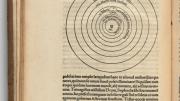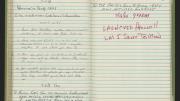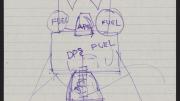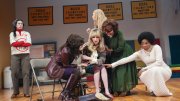Fifty years after the first moon landing, it’s still hard to place the importance of Neil Armstrong and Buzz Aldrin’s initial lunar footsteps in the context of human history. There’s the feat itself, but also the centuries of scientific discoveries that made spaceflight possible.
Small Steps, Giant Leaps: Apollo 11 at Fifty, an exhibit in Houghton Library open from April 29 to August 3, displays not only artifacts used during the Apollo 11 mission, but also seminal texts from Copernicus, Galileo, and Newton, who paved the way for NASA’s mission centuries in advance. “I think there are a lot of places that could tell one part of this story or the other,” said curator John Overholt, “but not too many that can do both.”
The exhibit is split into two sides, one drawing from Houghton’s collection, and the other from the collection of an anonymous Harvard alumnus with an extensive set of artifacts from the history of human flight, from the Wright Brothers through the Apollo 11 mission.
The materials are displayed roughly chronologically, starting with a first edition of Copernicus’s De Revolutionibus Orbium Coelestium, his foundational work on the heliocentric theory published just before his death. (Read “The Copernicus Quest,” on a Harvard scholar’s search for Copernicus manuscripts.) The idea that the Earth was not at the center of the universe was so controversial that Copernicus’s editor, Andreas Osiander, inserted an unauthorized preface suggesting the work was meant purely as a hypothetical exercise.
It sits alongside Newton’s Philosophiae Naturalis Principia Mathematica, which defines the fundamental laws of gravity and mechanics that, hundreds of years later, enabled spaceflight calculations. Two displays over, Galileo Galilei’s Sidereus Nuncius shows the first illustration of the moon as seen through a telescope, debunking the idea of the satellite as a heavenly realm.
The Houghton side of the exhibit grounds the viewer in both scientific history and pop-culture visions of the moon. Amazing Stories, a science-fiction “pulp” from 1929, shows two astronauts in bright-red suits jumping around a lunar setting. In another book, published in 1859, Richard Adams Locke debunks the myth that the moon has a vast population of human beings.
The loaned materials in the other side of the exhibit focus on flight and spaceflight itself. Original publications of the Wright Brothers are followed by Konstantin Tsiolkovsky’s calculations of the minimum speed required to leave Earth’s orbit, and the first published images of the planet from space.
The selections from Apollo 11 include Armstrong’s iconic photograph of Aldrin taken on the moon and The New York Times front page from the day after the moon landing, both signed by all three Apollo 11 astronauts (including Michael Collins, in the command module), but some of the exhibit’s most striking material is its least flashy and most intimate.
A detailed engineering turnover log—describing the day-to-day adjustments for the LM-5 Eagle, the mission’s lunar module—largely resists non-engineer readers. But on the day of the launch, the log concludes with a triumphant, bright-red note: “LAUNCHED APOLLO 11 LM 5 TO THE MOON.”
Another display includes a sketch of the lunar module that Armstrong used to help explain the upcoming mission to his father, drawn in purple on a loose-leaf sheet of paper. “I just think that’s an amazingly intimate connection to the mission,” Overholt said. “To have something Neil Armstrong made for his dad.” Below the iconic Times front page is the front page of the Wapakoneta Daily News—Armstrong’s hometown paper. “NEIL STEPS ON THE MOON,” it says. The picture is not of the astronaut himself, but rather of his parents outside their home, beaming with joy.
It’s easy to view the moon landing as a larger-than-life occurrence, far removed from everyday life. But the greatest strength of the Houghton exhibit is that it makes Apollo 11 and the centuries of science before it seem personal. It brings the moon a little bit down to Earth.











